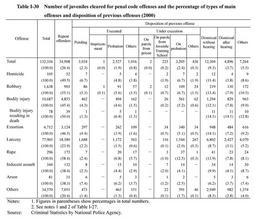| Previous Next Index Image Index Year Selection | |
|
|
2. Offenses committed by juvenile offenders The percentage of repeat offenders in all juvenile offenders continued to decrease from 1993 to 1997, and then turned upward. (See Table I-27 ).
Table I-30 shows the percentage of types of offenses and dispositions of previous offense among juveniles cleared for penal code offenses excluding professional negligence in traffic accidents in 2000 (For an overview of the treatment for juvenile offenders, see Part III, Chapter 2, Section 1 ). Table I-30 Number of juveniles cleared for penal code offenses and the percentage of types of main offenses and disposition of previous offenses (2000) As for juveniles cleared for heinous offenses such as homicide and robbery, or violent offenses such as bodily injury, extortion and rape, the percentage of these juveniles who had previously been cleared had a high share.Viewed in connection with previous dispositions, the percentage of juveniles who had been dismissed with or without hearing in their previous dispositions was the highest. This resulted from that fact that most juvenile offenders were dismissed with or without a hearing in their dispositions. However, as for juveniles cleared for the offenses mentioned above that were frequently committed by repeat offenders, the percentage of those who were on probation was high when they committed the offenses. As for juveniles cleared for homicide, robbery, bodily injury resulting in death, rape and arson, the percentage of those who committed the offense after the probation imposed in the previous disposition was completely executed was high. These facts suggest that juveniles who were cleared for heinous or violent offenses should have been subjected to supervision before they committed the offense. |
